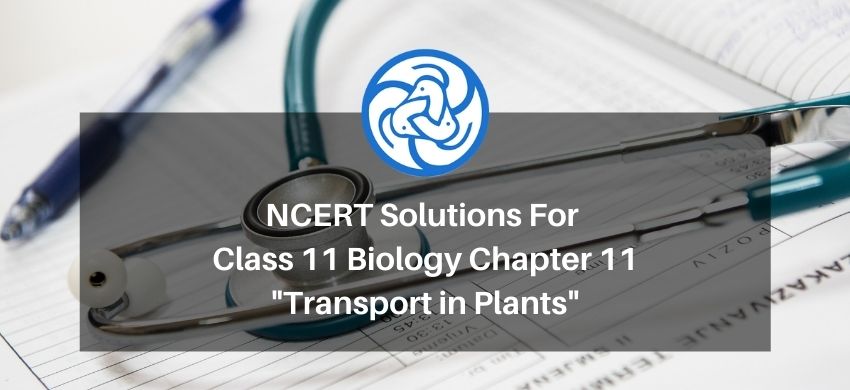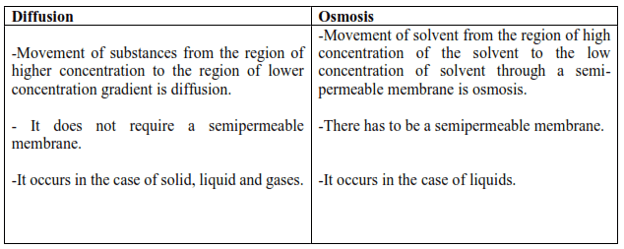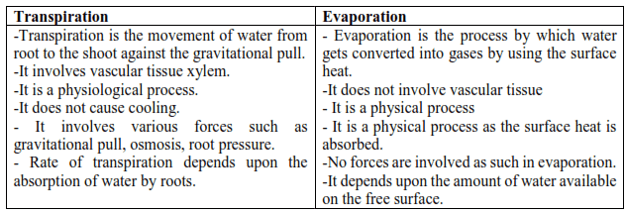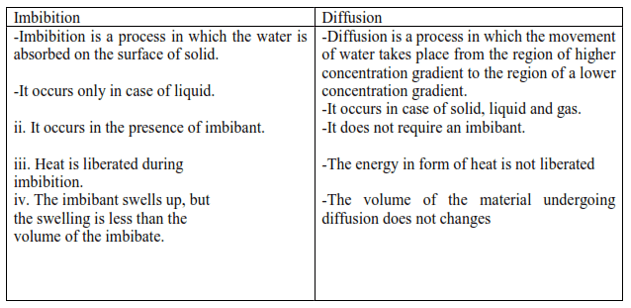
NCERT Solutions for Class 11 Biology chapter 11 Transport in Plants PDF
Hey, are you a class 11 student and looking for ways to download NCERT Solutions for Class 11 Biology chapter 11 Transport in Plants PDF? If yes. Then read this post till the end.In this article, we have listed NCERT Solutions for Class 11 Biology chapter 11 Transport in Plants in PDF that are prepared by Kota’s top Doctor’s Faculties by keeping Simplicity in mind.
If you want to learn and understand class 11 Biology chapter 11 "Transport in Plants" in an easy way then you can use these solutions PDF.
NCERT Solutions helps students to Practice important concepts of subjects easily. Class 11 Biology solutions provide detailed explanations of all the NCERT questions that students can use to clear their doubts instantly.
If you want to score high in your class 11 Biology Exam then it is very important for you to have a good knowledge of all the important topics, so to learn and practice those topics you can use eSaral NCERT Solutions.
In this article, we have listed NCERT Solutions for Class 11 Biology chapter 11 Transport in Plants PDF that you can download to start your preparations anytime.
So, without wasting more time Let’s start.
Download NCERT Solutions for Class 11 Biology chapter 11 Transport in Plants PDF
Question 1. What are the factors affecting the rate of diffusion?
Solution. -Diffusion refers to the movement of a substance (solid, liquid, gases) from the region of higher concentration to the region of lower concentration.
Factors that affect the rate of diffusion are:
-Concentration gradient
-Membrane permeability
-Temperature
- Pressure
Question 2. What are porins? What role do they play in diffusion?
Solution. Porins are the proteins that form large pores in the outer membranes of certain cell organelles such as plastids, mitochondria and some bacteria they allow molecules up to the size of small proteins to pass through them.
The role played by porins in diffusion:
- Certain bigger molecules take longer time to cross the biological membrane based on the concentration gradient; hence, their exchange occurs with the help of the porin proteins.
- There are special porin proteins which carry out the diffusion of water they are known as aquaporins.
Question 3. Describe the role played by protein pumps during active transport in plants.
Solution. The role played by the protein pumps during active transport is as follows:
-Protein pump transfers the substances against the concentration gradient.
-They transfer the movement of the molecule from the lower concentration gradient to a higher concentration gradient (uphill transport). They consume energy in order to carry out the transport.
-In root hairs, they pump ions from soil to the cytoplasm of the epidermal cells.
Question 4. Explain why pure water has the maximum water potential.
Solution. Water potential is defined as the concentration of water in the system. It is directly proportional to the kinetic energy possessed by the water.
When the water is pure, and no solutes are dissolved in water, the motion of the molecules is random. When the solute is added it the random motion of the molecule reduces hence reducing the water potential.
Hence it is considered that at standard temperature and pressure, the water potential of the molecules is zero. It is represented by the symbol psi $\left(\Psi_{w}\right)$.
Question 5. Differentiate between the following:
Solution (a) Diffusion and Osmosis

(b) Transpiration and Evaporation (3marks)

(c) Osmotic Pressure and Osmotic Potential

(d) Imbibition and Diffusion

(e) Apoplast and Symplast pathways of movement of water in plants.

(f) Guttation and Transpiration


Question 6. Briefly describe water potential. What are the factors affecting it?
Solution. Water potential is defined as the concentration of water in the system. It is directly proportional to the kinetic energy possessed by the water.
When the water is pure, and no solutes are dissolved in water, the motion of the molecules is random. When the solute is added it the random motion of the molecule reduces hence Teducing the water potential. Hence it is considered that at standard temperature and pressure, the water potential of the molecules is zero. It is represented by the symbol psi $\left(\Psi_{w}\right)$
- Factors affecting the water potential are as follows:
1. Solute potential
$\left(\psi_{\mathrm{s}}\right)$
2. Pressure
potential $\left(\psi_{\mathrm{p}}\right)$
3. Matric potential
4. Temperature
5. Pressure
6. Loss or gain of water
Question 7. What happens when a pressure greater than the atmospheric pressure is applied to pure water or a solution?
Solution. If the pressure greater than the atmospheric pressure is applied, then the water potential of the solution increases.
This happens because when the water enters the plant, then the pressure is built up against the cell wall. When the water enters the cell wall then it becomes turgid. The value of the potential of water is positive and is measured in bars.
Question 8. (a) With the help of well-labelled diagrams, describe the process of plasmolysis in plants, giving appropriate examples.
(b) Explain what will happen to a plant cell if it is kept in a solution having higher water potential.
Solution. A solution having higher water potential is referred to as the hypotonic solution. If the plant cell is kept in the solution having higher water potential then the plant cell will absorb water which is referred to endosmosis. This will make the plant cell turgid. When the plant cell is saturated with the water the protoplasm will exert the pressure on the walls hence causing the movement to stop.
a) Plasmolysis is the shrinkage of protoplast from the cell wall due to the excessive loss of water from the plants

-When a plant cell is placed in a hypertonic solution, the plant cell loses water which reduces the
turgor pressure making the plant cell flaccid. The loss of water from the plant is known as
wilting.
-When the plant is watered and the cells absorb water they become turgid.
b) A solution having high water potential is referred to as the hypotonic solution. If the plant cell is kept in the solution having higher water potential then the plant cell will absorb water which is referred to endosmosis. This will make the plant cell turgid. When the plant cell is saturated with the water the protoplasm will exert the pressure on the walls hence causing the movement to stop.
Question 9. How is the mycorrhizal association helpful in absorption of water and minerals in plants?
Solution. Mycorrhizae is the symbiotic association between the fungus and the roots of higher plants. It is formed as a network of fungal filaments around the young roots or by penetrating root cells.
Role of the fungus in mycorrhizae:
- Fungal hyphae help in the absorption of water where the roots of higher plants cannot penetrate. Since the pore size of hyphae is larger it is able to extract more amount of water from the ground.
Role of roots in symbiotic association:
- The roots of higher plants provide sugar and nitrogen-containing compounds.
- Other significance mycorrhizae help in germination of seeds of certain plants such as "Pinus" without the association of mycorrhizae the plant is unable to germinate.
Question 10. What role does root pressure play in water movement in plants?
Solution. Root pressure is the positive pressure that develops in the roots of plants by the active absorption of nutrients from the soil.
The role played by the root pressure in the transport of water:
- Root pressure is responsible to push up water up to small heights in the stem of a plant.
- It can provide a modest push in the process of water transport and establishes the continuous chain of water molecules in the xylem.
- Root pressure does not account for the majority of water transport; most plants meet their need by the transpiratory pull.
Question 11. Describe the transpiration pull model of water transport in plants. What are the factors
influencing transpiration? How is it useful to plants?
Solution. Transpiration pull model/Cohesion tension model
In tall trees, the transportation of water occurs with the help of the transpirational pull generated by high temperature or loss of water from the stomatal pores. This is called the cohesion-tension model of water transport.
- During the daytime, the water is lost through transpiration (by the leaves to the surroundings) causes the guard cells and other epidermal cells to become flaccid. The water is transported from the xylem and negative pressure or tension in the xylem vessels is created from the surfaces of the leaves to the tips of the roots, through the stem.
Ls a result, the water present in the xylem is pulled as a single column from the stem. The cohesion and adhesion forces of the water molecules and the cell walls of the xylem vessels prevent the water column from splitting.
Factors affecting the rate of transpiration are as follows:
1. Temperature: The rate of transpiration increases with the increase in atmospheric temperature because the temperature increases the rate of water evaporation from the cell surface, opens the stomata and decreases the relative humidity of the atmosphere.
2. Relative humidity: Relative humidity is the percentage of water vapour present in the air at a given time and temperature relative to the amount required to be present to make the air saturated at that temperature. The rate of transpiration is inversely proportional to the relative humidity.
3. Light: In most plants, the stomata open in the presence of light and close in darkness. The rate of transpiration increases in the presence of light and decreases in darkness.
4. Wind: Transpiration is lower in still air because the water vapour accumulates around the transpiring organs. The movement of air increases the rate of transpiration by removing the saturated air around the leaves.
Importance of transpiration:
1. The ascent of xylem sap: Ascent of sap mostly occurs due to the transpiration pull exerted by
the transpiration of water.
2. Maintaining the cell shape: Transpiration maintains the shape and structure of plant parts
by keeping the cells turgid.
3. Removal of excess water: Plants absorb far more amount of water than actually required
by them. Thus, transpiration removes the excess of water.
Question 12. Discuss the factors responsible for ascent of xylem sap in plants.
Solution. Factors affecting the ascent of xylem sap in plants:
1. Cohesion: It is the mutual attraction between water molecules.
2. Adhesion: It is the attraction of water molecules to polar surfaces (such as the surface of treachery elements).
3. Surface tension: Water molecules are attracted to each other in the liquid phase more than to
water in the gas phase.
4. Root pressure: It is positive pressure which pushes sap from below due to the active absorption by roots.
5. Transpiration pull: Transpiration in aerial parts brings the xylem sap under negative pressure or tension due to their continuous withdrawal of water.
Question 13. What essential role does the root endodermis play during mineral absorption in plants?
Solution. - Endodermal cells play an essential role in the transport of a substance. It carries out active and passive transport of the substances across the membrane.
-The selected minerals pass through it due to the deposition of suberin and lignin.
-The endodermal cells also contain the transport proteins known as porins they help the plant to carry out the quick transport of the substances.
-The presence of these proteins helps in the quick transport of the materials across the membrane.
Question 14. Explain why xylem transport is unidirectional and phloem transport bi-directional.
Solution. During the growth of a plant, its leaves act as the source of food as they carry out photosynthesis. The phloem conducts the food from the source to the sink (the part of the plant requiring or storing food).
During spring, this process is reversed as the food stored in the sink is mobilised toward the growing buds of the plant, through the phloem. Thus, the movement of food in the phloem is bidirectional (i.e., upward and downward).
The transport of water in the xylem takes place only from the roots to the leaves. Therefore, the movement of water and nutrients in the xylem is unidirectional.
Question 15. Explain pressure flow hypothesis of translocation of sugars in plants.
Solution - Leaves are referred to as the food factory of the plants the food is synthesised in the mesophyll cells of the leaves. The glucose synthesised during the process of photosynthesis is converted into the circulating sugar sucrose. The sucrose is then moved into the source cells this happens when the water moves from xylem vessels to the adjacent phloem vessels hence increasing the hydrostatic pressure and transporting the sucrose into the sieve cells of the phloem.
- The sucrose present in the sink gets converted into storage sugar starch or cellulose. This reduces the hydrostatic pressure in the cells of the sink region. Due to the difference in the pressure, the sugar is transported from the source region to the sink region.
Question 16. What causes the opening and closing of guard cells of stomata during transpiration?
Solution. - Opening and closing of stomata are caused by the exosmosis and endosmosis of water in the guard cells. In normal condition, the stomata tend to open during the day time in response to light and to close at night.
- The opening or closing of the stomata is a change in the turgidity of the guard cells. When water flows inside the guard cells it becomes turgid and kidney-shaped as the thin walls get extended and thick walls become slightly concave causing the opening of the stomal aperture.
- When the guard cells lose water turgor pressure reduces due to water loss (or water stress), the elastic inner walls regain their original shape, the guard cells become flaccid and dumbbell-shaped causing the closure of stomata.
Also Read,
Class 11 Chemistry Notes Free pdf.
Class 11 Biology Book Chapterwise Free pdf.
Class 11 Biology Exemplar Chapterwise Free pdf.
If you have any Confusion related to NCERT Solutions for Class 11 Biology chapter 11 Transport in Plants PDF then feel free to ask in the comments section down below.
To watch Free Learning Videos on Class 11 Biology by Kota’s top Doctor’s Faculties Install the eSaral App
